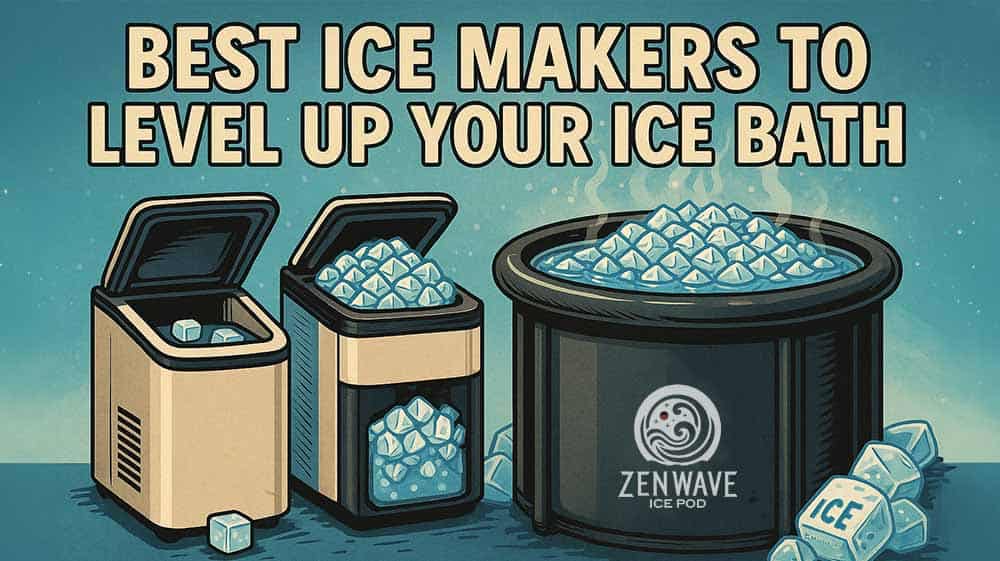If you’ve ever hauled six bags of ice from a gas station, only to watch it disappear in five minutes, you already know the problem: store-bought ice is a pain. It’s expensive. It melts in transit. And if you plunge more than once a week, it adds up fast — in time, money, and frustration.
That’s why serious plungers eventually graduate to an ice maker.
The right machine gives you control. It turns cold exposure into a repeatable habit — not a logistical nightmare. But here’s the catch: most ice makers on the market aren’t made for this. They’re built for cocktails, not cold therapy.
This guide cuts through the noise. We’re not reviewing machines for bar owners or restaurant managers. We’re looking at ice makers that actually work for ice baths — based on output, ice quality, storage, and setup. And more than that — we’ll walk through what really matters for building a reliable ice routine. Whether you’re just getting started or looking to upgrade your recovery setup, this is the breakdown that actually matters.
What Actually Matters When Choosing an Ice Maker
Most people underestimate just how much ice it takes to get an ice bath cold enough to actually work. This section sets the record straight.
If you’re plunging with purpose — aiming for 50°F or lower — you’re going to need a serious volume of ice. A typical 50-gallon tub needs about 125 lbs of fully melted ice to drop from 70°F to 50°F. That’s not a guess — it’s based on the energy required to cool water and the latent heat absorbed as ice melts. No melt, no chill.
You can calculate your exact ice needs for your cold plunge setup with our ice bath calculator.
This is where most ice makers fall short. Machines that produce 26–40 lbs/day might sound impressive until you realize they won’t even get you halfway to a full plunge. You either need to store up over several days or invest in a unit that can keep up with your routine.
When evaluating ice makers for ice baths, skip the cocktail-friendly features and zero in on specs that actually matter for cold exposure:
- Daily Output (lbs/day): This is your top priority. Can it generate enough ice to support your weekly plunge frequency?
- Storage Bin Capacity: Bigger bins mean you can batch prep without losing cold. Small bins mean constant cycling and melt waste.
- Ice Shape & Size: Block and thick cube ice cool more slowly but last far longer in the tub. Nuggets cool fast, but melt even faster.
- Water Source Type: Manual fill is simplest. Jug-fed adds scale. Plumbed systems are best for high-frequency plungers.
- Plunge Frequency: Match your actual habit, not your ideal self. Start small if you’re new. Scale up as needed.
Cold exposure is already hard. Your ice setup shouldn’t make it harder. Get a machine that works with your flow, not against it.
If you’re storing ice between plunges or letting water sit for days, it’s worth understanding how to keep your ice bath water clean — since ice, especially if homemade, can introduce contaminants over time.
Best Ice Makers for Ice Baths by Type
Different setups demand different machines. This section breaks down the most effective types of ice makers for cold plunging — and recommends proven products for each.
1. Countertop Ice Makers for Light Ice Bath Use
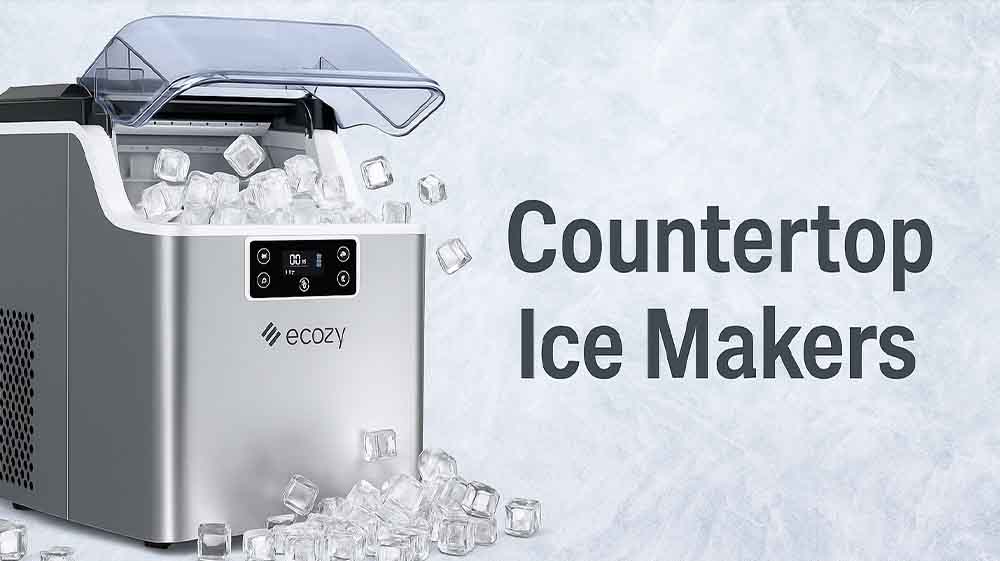
For beginners or occasional plungers, countertop units are the easiest and most affordable way to produce your own ice. These machines don’t need a water line, cost under $200, and are compact enough to run in any room.
That said, they require planning. You’ll need to pre-make batches and store them in bags to accumulate enough for a full plunge.
💡Product Pick: EUHOMY Ice Maker (95 lbs/day)
Best For: Daily plungers who want a reliable, semi-automated setup without going full commercial. This plumbed unit cranks out 95 lbs of cube ice daily — enough for most solo or couple-use setups. The 33 lb bin means you don’t need to babysit it all day, and the plumbed design means no more manual refills.
Specs at a Glance:
- 🧊 Output: 95 lbs/day
- 🧺 Storage Bin: 33 lbs
- 🚰 Water Source: Plumbed connection
✅ Check Availability on Amazon
2. Jug-Fed Ice Makers for Moderate Ice Bath Routines
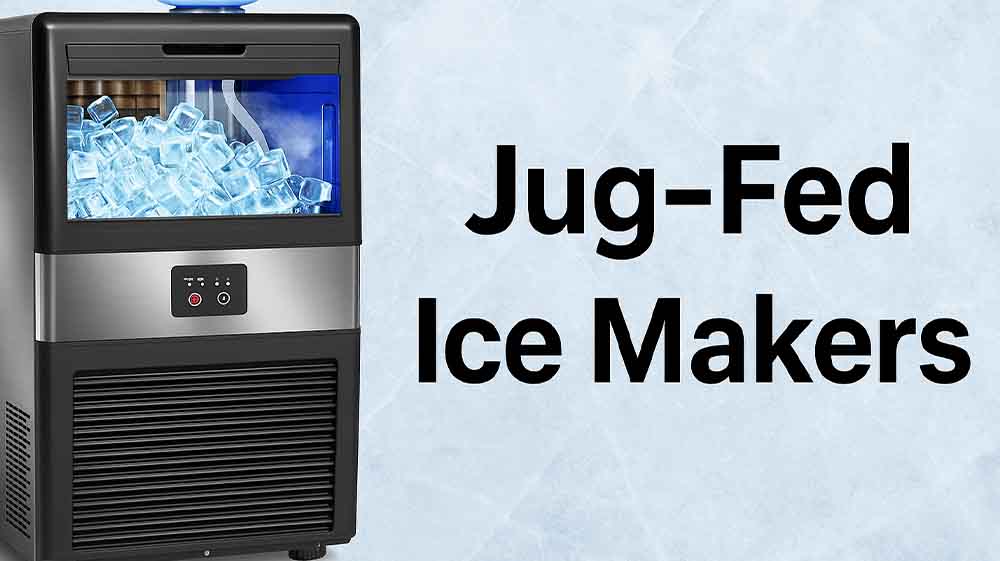
If you’re plunging 3–5 times a week and don’t want to mess with plumbing, jug-fed units are a smart middle ground. These machines use 5-gallon jugs or built-in reservoirs, offering solid output with no permanent install.
Just top off the water, empty the bin between runs, and stay on schedule.
💡 Product Pick: Freestanding Cabinet Ice Maker (80 lbs/day)
Best For: Regular plungers (3–5 times/week) who want serious output without needing plumbing. With 80 lbs/day production, this unit easily supports short or moderate-length plunges. It offers three cube size options and uses a jug-fed or built-in reservoir system — no hard water lines needed.
Specs at a Glance:
- 🧊 Output: 80 lbs/day
- 🧊 Ice Type: Cubes (3 sizes)
- 🚰 Water Source: 5-gallon jug or internal reservoir
✅ Check Availability on Amazon
3. Plumbed Ice Makers for Daily Cold Plungers
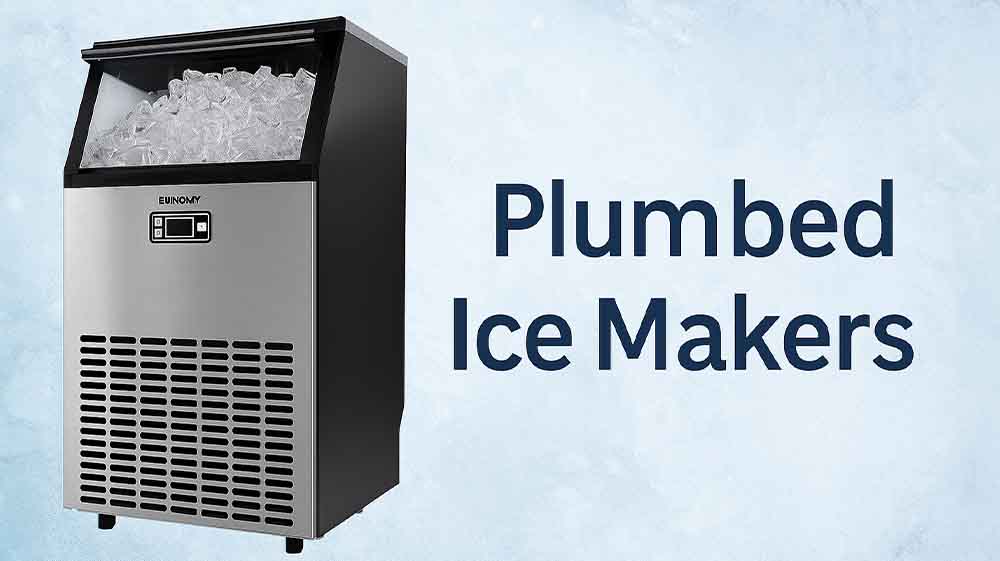
For high-frequency plungers, automation becomes critical. A plumbed ice maker connects directly to your water supply, meaning it can run continuously without manual refills.
It’s more of an install than a countertop or jug-fed unit, but the payoffs — convenience and consistency — are worth it if you’re serious.
💡 Product Pick: EUHOMY Ice Maker (95 lbs/day)
Best For: Daily plungers who want a reliable, semi-automated setup without going full commercial. This plumbed unit cranks out 95 lbs of cube ice daily — enough for most solo or couple-use setups. The 33 lb bin means you don’t need to babysit it all day, and the plumbed design means no more manual refills.
Specs at a Glance:
- 🧊 Output: 95 lbs/day
- 🧺 Storage Bin: 33 lbs
- 🚰 Water Source: Plumbed connection
✅ Check Availability on Amazon
4. High-Output Commercial Ice Makers
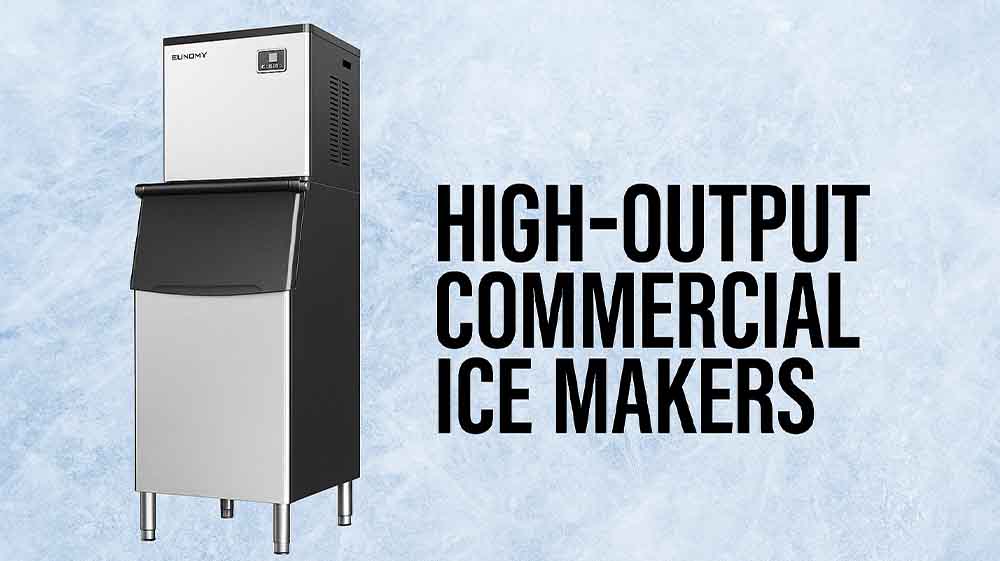
Built for clinics, gyms, or shared recovery setups, these machines are overkill for casuals — but a dream for heavy use.
You’ll need a dedicated space and solid drainage, but once installed, you’ll never worry about ice again.
💡 Product Pick: EUHOMY Commercial Ice Maker (400 lbs/day)
Best For: Recovery clinics, teams, or families with multiple plunge users. This machine is a tank — producing 400 lbs of ice daily and storing up to 250 lbs. It’s perfect for shared environments, high-frequency recovery setups, or anyone tired of rationing ice.
Specs at a Glance:
- 🧊 Output: 400 lbs/day
- 🧺 Storage Bin: 250 lbs
- 🚰 Water Source: Manual fill
✅ Check Availability on Amazon
5. Ice Block Molds for DIY Ice Bath Cooling

If you’ve got the freezer space, nothing beats block ice for melt time and cold retention. These molds let you prep ahead, stack, and store dense ice that holds up longer than nuggets or cubes.
Ideal for supplementing your machine or going fully manual on a budget.
💡 Product Pick: Alaskey Extra Large Ice Block Mold
Best For: Budget setups, DIY users, or anyone wanting the longest-lasting ice possible. Hands down the best block molds on the market. They’re sturdy, easy to fill, and won’t crack or spill when stacking. Each mold comes with a secure lid, making batch prep clean and freezer-friendly.
Specs at a Glance:
- 🧊 Shape: Rectangular, stackable with lids
- 🧱 Material: Silicone, crack-resistant
- 🧺 Freezer Fit: Stackable for bulk storage
✅ Check Availability on Amazon
Why Some Users Ditch Ice Altogether: Water Chillers
Let’s be real — managing ice is a chore. Even with a machine, you’re freezing batches, bagging cubes, and planning ahead just to make sure your tub is cold when you need it.
That’s where water chillers come in.
These units cool the water in your tub directly — no ice required. Set your target temperature, plug in the chiller, and you’ve got cold water on demand, 24/7.
It’s a bigger investment upfront, but the payoff is real: less hassle, tighter control, and no more wasted time.
- Set-and-forget automation: No batching, no bagging, no melt.
- Long-term savings: Ice adds up. Chillers pay for themselves.
- Precision cooling: You choose the temp — and it holds.
Product Pick: Penguin Chillers Cold Therapy Chiller
If you’re plunging more than a few times a week and want the easiest, most consistent setup possible, the Penguin Chiller Cold Therapy Chiller is the move.
- Cooling Power: 3/4HP (7500 BTU/hour) compressor
- Built-in pump and weatherproof housing
- Max Tub Size: Up to 150 gallons
- Lowest Temp: Can hit 37°F in ideal conditions
- Monthly Cost: Around $18–28 to run continuously
Penguin is one of the few U.S.-based brands that actually makes their own chillers. That matters.
If something breaks, you’re not waiting months for parts from overseas. You get fast support, solid warranty coverage, and peace of mind.
The only downside? No built-in ozone or UV — but those are easy add-ons if you want them.
If you want zero-hassle, cold-on-command performance, this is it.
✅ Best Place to This Water Chiller: Plunge Junkies
Want to see other top contenders? Check out our full guide to the best water chillers for ice baths.
Ice Maker Mistakes to Avoid
Not all ice makers are built with ice baths in mind. These are the most common traps we see — and what to skip if you want a setup that actually works.
❌ Tiny Storage Bins (<5 lbs)
You’ll spend more time babysitting the machine than plunging. If the bin fills too fast, the machine stops cycling, and you’re stuck constantly dumping and restarting.
❌ Nugget Ice as Your Main Cooling Source
Nuggets melt fast. You’ll need double or triple the volume compared to cubes or blocks to reach the same cooling effect. Fine for topping off — terrible as your base.
❌ Commercial Units Without a Drain Line
If it’s built for heavy output, it probably needs a floor drain. Don’t get stuck with a 200-lb machine you can’t even run in your space.
❌ Bullet Ice Machines With No External Storage Option
They make decent ice — but you can’t store enough at once. Without a plan to bag and freeze the output, it’s a short session every time.
Ice Type and Melt Rate for Ice Baths: What Actually Works
When it comes to cold plunges, not all ice is created equal. The type and shape of ice you use determines not just how fast the water cools, but whether it stays cold long enough to matter.
Here’s why:
- Smaller ice = faster chill, shorter hold. Nugget and chip ice have more surface area, which helps them melt quickly and cool the water faster — but they burn out in minutes.
- Larger ice = slower chill, longer retention. Blocks and thick cubes melt slowly, pull more heat from the water over time, and help you maintain consistent plunge temps.
Let’s break it down:
- Nugget Ice: Best for quick plunges (3–5 minutes) or if you’re starting with cooler water. But it melts fast — so unless you’re jumping in right away, the temp rises before the plunge even starts.
- Cube Ice: A good middle-ground. Cools water in a reasonable time and holds temp for 5–10 minute sessions. Still requires a decent quantity to stay below 55°F.
- Block Ice: King of cold retention. It takes longer to cool the water, but once it does, it holds. Ideal for outdoor setups, long soaks, or anyone using low-insulated tubs.
Why this happens: melting ice absorbs energy — called latent heat. The slower the melt, the longer it pulls heat from the water. Bigger ice = more cooling potential over time.
| Ice Type | Melt Speed | Cold Retention | Verdict |
| Nugget | Fast | Low | Inefficient unless used instantly |
| Cube | Medium | Good | Most versatile for general use |
| Block | Slow | Best | Ideal for hot setups and long plunges |
Pro tip: you can supplement your stash with homemade block ice. It’s the most cost-effective way to add long-lasting chill without buying a second machine. Also be sure to check out our other ways to make lots of ice for your ice bath at home.
Final Thoughts
Most people underestimate how much ice they need—and waste money on machines that can’t keep up. This guide’s built for cold plungers, not cocktail parties. Every pick here maps directly to how often you plunge, how long you stay in, and what kind of cold you need to hold.
Skip the gimmicks. Choose the machine that fits your habit.
Let’s make your next ice bath colder, faster, and easier

